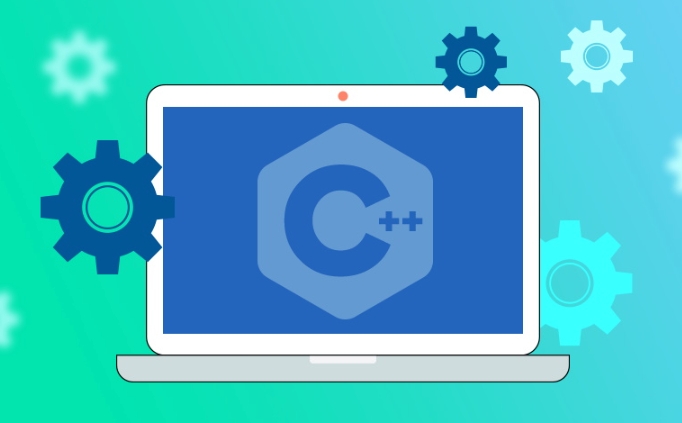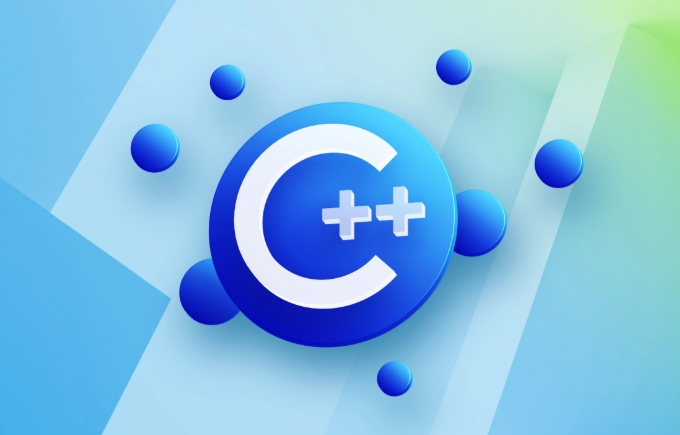C tutorial on the Standard Template Library (STL)
STL(标准模板库)是C++标准库的重要组成部分,包含容器、迭代器和算法三大核心组件。1. 容器如vector、map、set用于存储数据;2. 迭代器用于访问容器元素;3. 算法如sort、find用于操作数据。选择容器时,vector适合动态数组,list适合频繁插入删除,deque支持双端快速操作,map/unordered_map用于键值对查找,set/unordered_set用于去重。使用算法时应包含<algorithm>头文件,并配合迭代器和lambda表达式。注意避免失效迭代器、删除时更新迭代器、不可修改map/set的key值,或使用范围for循环提高安全性。掌握STL能显著提升代码效率与可读性。

如果你刚开始学 C++,可能已经听说过 STL 这个词。它全称是 Standard Template Library(标准模板库),是 C++ 中非常强大的一部分,提供了一系列通用的数据结构和算法。这篇文章不会从头讲语法,而是直接带你了解 STL 的核心组成、如何使用常见容器和算法,并给出一些实用建议。

什么是 STL,为什么重要?
STL 是 C++ 标准库的一部分,主要包含三个核心组件:容器(Containers)、迭代器(Iterators) 和 算法(Algorithms)。它们共同作用,让你可以高效地处理数据。

- 容器用来存储数据,比如
vector、map、set。 - 迭代器像指针一样用来访问容器中的元素。
- 算法则是对这些数据进行操作的函数,例如排序、查找等。
用 STL 的好处在于你不用自己实现链表、动态数组这些基础结构,而且代码会更简洁、可读性更高。
常见容器怎么选?看需求
C++ 提供了多种容器类型,每种适用于不同场景。以下是最常用的几个:

-
vector:动态数组,适合顺序访问,尾部插入/删除快。 -
list:双向链表,适合频繁在中间插入或删除元素。 -
deque:双端队列,支持两端快速插入。 -
map/unordered_map:键值对集合,前者基于红黑树有序,后者基于哈希无序但更快。 -
set/unordered_set:集合类型,用于去重,同理有有序和无序之分。
举个例子,如果你需要一个列表,随时添加元素又不确定大小,首选 vector;如果要根据关键字快速查找,就用 map 或 unordered_map。
小提示:尽量避免用
vector<bool>,这个特化版本行为跟普通 vector 不太一样,容易踩坑。
算法怎么用?别自己造轮子
STL 提供了大量的算法函数,都在 <algorithm> 头文件里。常见的如:
-
sort():排序 -
find():查找元素 -
copy():复制数据 -
transform():转换数据
这些函数通常接受两个迭代器作为参数,表示操作范围。例如:
#include <algorithm>
#include <vector>
std::vector<int> v = {5, 2, 8, 1};
std::sort(v.begin(), v.end()); // 排序后变成 {1, 2, 5, 8}你可以配合 lambda 表达式来自定义排序规则或者判断条件,这样写出来的代码既简洁又灵活。
注意:有些算法返回的是迭代器而不是索引,使用前记得检查是否合法(比如
find()找不到时返回end())。
使用迭代器时要注意什么?
迭代器是连接容器和算法的桥梁,但在使用过程中有几个地方容易出错:
- 避免使用已经失效的迭代器。例如你在遍历
vector时进行了扩容操作(比如push_back),可能会导致迭代器失效。 - 删除元素时注意更新迭代器。例如使用
list.erase(it++)是一种常见做法。 - 在使用
map或set时,不要尝试修改 key 的值,因为这会影响内部结构。
如果你不太确定迭代器的行为,可以用范围 for 循环来简化操作,比如:
for (const auto& item : my_vector) {
std::cout << item << std::endl;
}这种方式更直观,也更安全。
基本上就这些。STL 是 C++ 编程中不可或缺的一部分,掌握好常用容器和算法,能让你写出更清晰、高效的代码。虽然一开始可能会觉得有点抽象,但多用几次就能上手了。
The above is the detailed content of C tutorial on the Standard Template Library (STL). For more information, please follow other related articles on the PHP Chinese website!

Hot AI Tools

Undress AI Tool
Undress images for free

Undresser.AI Undress
AI-powered app for creating realistic nude photos

AI Clothes Remover
Online AI tool for removing clothes from photos.

Clothoff.io
AI clothes remover

Video Face Swap
Swap faces in any video effortlessly with our completely free AI face swap tool!

Hot Article

Hot Tools

Notepad++7.3.1
Easy-to-use and free code editor

SublimeText3 Chinese version
Chinese version, very easy to use

Zend Studio 13.0.1
Powerful PHP integrated development environment

Dreamweaver CS6
Visual web development tools

SublimeText3 Mac version
God-level code editing software (SublimeText3)

Hot Topics
 1793
1793
 16
16
 1736
1736
 56
56
 1587
1587
 29
29
 267
267
 587
587
 C tutorial for people who know Python
Jul 01, 2025 am 01:11 AM
C tutorial for people who know Python
Jul 01, 2025 am 01:11 AM
People who study Python transfer to C The most direct confusion is: Why can't you write like Python? Because C, although the syntax is more complex, provides underlying control capabilities and performance advantages. 1. In terms of syntax structure, C uses curly braces {} instead of indentation to organize code blocks, and variable types must be explicitly declared; 2. In terms of type system and memory management, C does not have an automatic garbage collection mechanism, and needs to manually manage memory and pay attention to releasing resources. RAII technology can assist resource management; 3. In functions and class definitions, C needs to explicitly access modifiers, constructors and destructors, and supports advanced functions such as operator overloading; 4. In terms of standard libraries, STL provides powerful containers and algorithms, but needs to adapt to generic programming ideas; 5
 What is the Standard Template Library (STL) in C ?
Jul 01, 2025 am 01:17 AM
What is the Standard Template Library (STL) in C ?
Jul 01, 2025 am 01:17 AM
C STL is a set of general template classes and functions, including core components such as containers, algorithms, and iterators. Containers such as vector, list, map, and set are used to store data. Vector supports random access, which is suitable for frequent reading; list insertion and deletion are efficient but accessed slowly; map and set are based on red and black trees, and automatic sorting is suitable for fast searches. Algorithms such as sort, find, copy, transform, and accumulate are commonly used to encapsulate them, and they act on the iterator range of the container. The iterator acts as a bridge connecting containers to algorithms, supporting traversal and accessing elements. Other components include function objects, adapters, allocators, which are used to customize logic, change behavior, and memory management. STL simplifies C
 Using std::chrono in C
Jul 15, 2025 am 01:30 AM
Using std::chrono in C
Jul 15, 2025 am 01:30 AM
std::chrono is used in C to process time, including obtaining the current time, measuring execution time, operation time point and duration, and formatting analysis time. 1. Use std::chrono::system_clock::now() to obtain the current time, which can be converted into a readable string, but the system clock may not be monotonous; 2. Use std::chrono::steady_clock to measure the execution time to ensure monotony, and convert it into milliseconds, seconds and other units through duration_cast; 3. Time point (time_point) and duration (duration) can be interoperable, but attention should be paid to unit compatibility and clock epoch (epoch)
 C tutorial for competitive programming
Jul 02, 2025 am 12:54 AM
C tutorial for competitive programming
Jul 02, 2025 am 12:54 AM
Learn C You should start from the following points when playing games: 1. Proficient in basic grammar but do not need to go deep into it, master the basic contents of variable definition, looping, condition judgment, functions, etc.; 2. Focus on mastering the use of STL containers such as vector, map, set, queue, and stack; 3. Learn fast input and output techniques, such as closing synchronous streams or using scanf and printf; 4. Use templates and macros to simplify code writing and improve efficiency; 5. Familiar with common details such as boundary conditions and initialization errors.
 How to use cin and cout for input/output in C ?
Jul 02, 2025 am 01:10 AM
How to use cin and cout for input/output in C ?
Jul 02, 2025 am 01:10 AM
In C, cin and cout are used for console input and output. 1. Use cout to read the input, pay attention to type matching problems, and stop encountering spaces; 3. Use getline(cin, str) when reading strings containing spaces; 4. When using cin and getline, you need to clean the remaining characters in the buffer; 5. When entering incorrectly, you need to call cin.clear() and cin.ignore() to deal with exception status. Master these key points and write stable console programs.
 C tutorial on the Standard Template Library (STL)
Jul 02, 2025 am 01:26 AM
C tutorial on the Standard Template Library (STL)
Jul 02, 2025 am 01:26 AM
STL (Standard Template Library) is an important part of the C standard library, including three core components: container, iterator and algorithm. 1. Containers such as vector, map, and set are used to store data; 2. Iterators are used to access container elements; 3. Algorithms such as sort and find are used to operate data. When selecting a container, vector is suitable for dynamic arrays, list is suitable for frequent insertion and deletion, deque supports double-ended quick operation, map/unordered_map is used for key-value pair search, and set/unordered_set is used for deduplication. When using the algorithm, the header file should be included, and iterators and lambda expressions should be combined. Be careful to avoid failure iterators, update iterators when deleting, and not modify m
 C tutorial for graphics programming with OpenGL
Jul 02, 2025 am 12:07 AM
C tutorial for graphics programming with OpenGL
Jul 02, 2025 am 12:07 AM
As a beginner graphical programming for C programmers, OpenGL is a good choice. First, you need to build a development environment, use GLFW or SDL to create a window, load the function pointer with GLEW or glad, and correctly set the context version such as 3.3. Secondly, understand OpenGL's state machine model and master the core drawing process: create and compile shaders, link programs, upload vertex data (VBO), configure attribute pointers (VAO) and call drawing functions. In addition, you must be familiar with debugging techniques, check the shader compilation and program link status, enable the vertex attribute array, set the screen clear color, etc. Recommended learning resources include LearnOpenGL, OpenGLRedBook and YouTube tutorial series. Master the above
 What is the volatile keyword in C ?
Jul 04, 2025 am 01:09 AM
What is the volatile keyword in C ?
Jul 04, 2025 am 01:09 AM
volatile tells the compiler that the value of the variable may change at any time, preventing the compiler from optimizing access. 1. Used for hardware registers, signal handlers, or shared variables between threads (but modern C recommends std::atomic). 2. Each access is directly read and write memory instead of cached to registers. 3. It does not provide atomicity or thread safety, and only ensures that the compiler does not optimize read and write. 4. Constantly, the two are sometimes used in combination to represent read-only but externally modifyable variables. 5. It cannot replace mutexes or atomic operations, and excessive use will affect performance.





